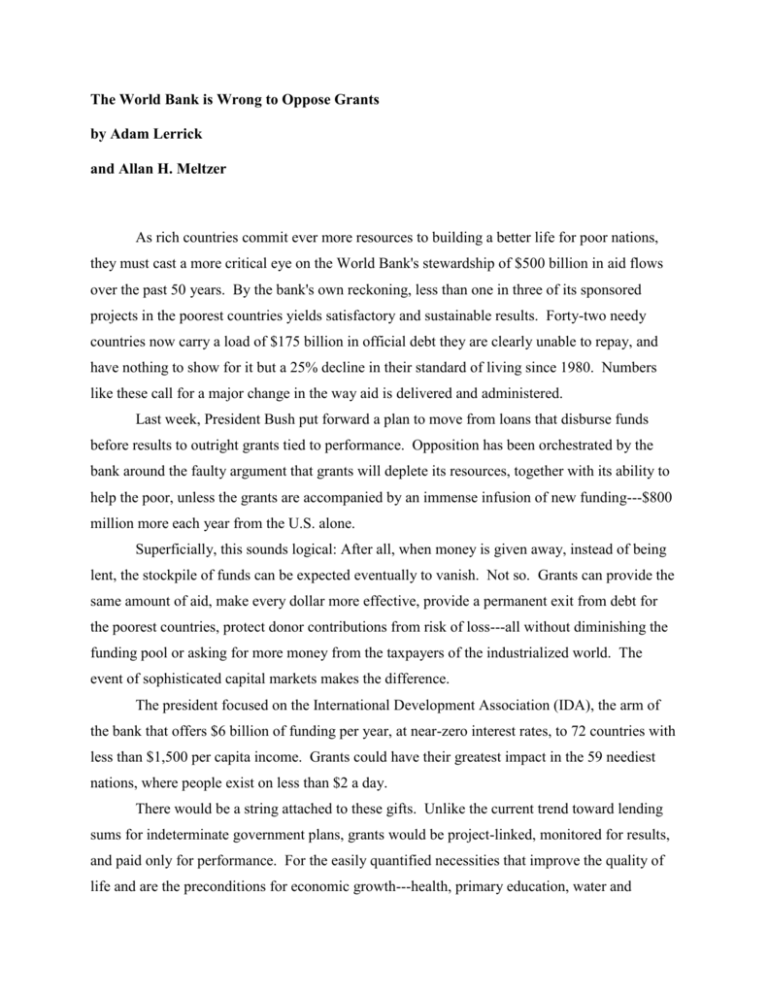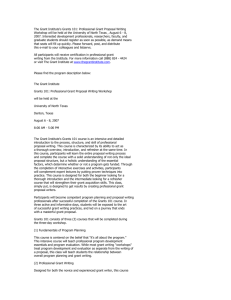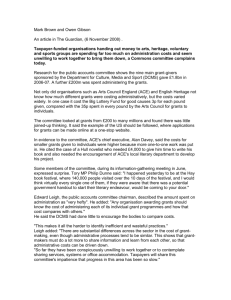The World Bank is Wrong to Oppose Grants
advertisement

The World Bank is Wrong to Oppose Grants by Adam Lerrick and Allan H. Meltzer As rich countries commit ever more resources to building a better life for poor nations, they must cast a more critical eye on the World Bank's stewardship of $500 billion in aid flows over the past 50 years. By the bank's own reckoning, less than one in three of its sponsored projects in the poorest countries yields satisfactory and sustainable results. Forty-two needy countries now carry a load of $175 billion in official debt they are clearly unable to repay, and have nothing to show for it but a 25% decline in their standard of living since 1980. Numbers like these call for a major change in the way aid is delivered and administered. Last week, President Bush put forward a plan to move from loans that disburse funds before results to outright grants tied to performance. Opposition has been orchestrated by the bank around the faulty argument that grants will deplete its resources, together with its ability to help the poor, unless the grants are accompanied by an immense infusion of new funding---$800 million more each year from the U.S. alone. Superficially, this sounds logical: After all, when money is given away, instead of being lent, the stockpile of funds can be expected eventually to vanish. Not so. Grants can provide the same amount of aid, make every dollar more effective, provide a permanent exit from debt for the poorest countries, protect donor contributions from risk of loss---all without diminishing the funding pool or asking for more money from the taxpayers of the industrialized world. The event of sophisticated capital markets makes the difference. The president focused on the International Development Association (IDA), the arm of the bank that offers $6 billion of funding per year, at near-zero interest rates, to 72 countries with less than $1,500 per capita income. Grants could have their greatest impact in the 59 neediest nations, where people exist on less than $2 a day. There would be a string attached to these gifts. Unlike the current trend toward lending sums for indeterminate government plans, grants would be project-linked, monitored for results, and paid only for performance. For the easily quantified necessities that improve the quality of life and are the preconditions for economic growth---health, primary education, water and sanitation---the grant system would count and pay for numbers of babies vaccinated, children that can read, and water and sewer services delivered to villages. No results, no funds expended. And no funds diverted to offshore bank accounts, vanity projects or private jets. Grants and loans have the same funding requirement when the level of aid is the same. Donors will not have to give more unless they wish to give more aid. The IDA extends 40-year loans that carry an interest rate of 0.75%. The present value of these payment promises is only 25 cents on the dollar and translates into a gift equal to 75% of their value. A loan that has a 75% gift component cannot cost more than an outright grant that covers 75% of program outlays. In both cases, countries pay the remaining 25%. How can lending $100 and asking for only $25 to be repaid be any different from giving $75? There is a hidden cost to the present system: The poorest borrowers seldom repay loans. In order to discredit the grant concept, confuse Western donors, and justify increased resources, the World Bank has swapped apples for oranges. Their calculations raise aid levels 33% by comparing grants covering 100% of program costs with traditional loans that contain only a 75% grant element. Again, if the same level of assistance is maintained, grants cannot cost more than loans. Shrinking resources, caused by the lack of loan repayments into a circulating aid pool, are always advanced as a reason to block the shift to grants. The bank's practices give the lie to this "reflow" claim, for many loans are never truly collected. Most debts are simply recycled to the same borrowers, with more added to cover interest payments. Ultimately, many debts must be forgiven, as in the current relief initiative that covers 41 of the neediest nations. Whether recycled or forgiven, loans are simply grants in disguise. A grant system would not rely on illusory reflows for self-sustainability. The pool of donor funds now used for lending, and future contributions, would be transformed into an endowment that invests in the capital markets and generates the income to supply grants. There are already $108 billion of rich-country contributions on the IDA's balance sheets, partly in loans and partly in cash. These cash balances, augmented by future loan repayments, would be invested for a conservative 8% return and eventually yield $8.6 billion in grants each year, while leaving the endowment intact. This stream will be leveraged by the capital markets, which will provide financing because the bank's responsibility for the lion's share of every payment will greatly reduce risk. Thus, an identical $108 billion in outstanding development programs would be sustained in perpetuity. As the IDA moves from lending to grants over a 40-year transition, the volume of development programs and the flow of financial resources to poor countries would match what would have been delivered by loans. Failures to repay old loans would reduce resources, but no more so than under lending. Lack of basic arithmetical skills cannot explain the bank's continued defense of an outdated method for delivering aid, designed at a time when direct loans were the only option. Capital markets are now able to provide financing, and willing to tolerate the risk that once deterred projects in the developing world. The institution does not welcome a career change from being an elegant banker dispensing large volumes of largesse to being a gritty development agency with a demanding workload. And it harbors a well-founded fear that, with grants, it must account for the effectiveness of programs. The bank will soon seek replenishment funding for the IDA, as happens every three years. The amount of money is significant; last time, it was $12 billion. Giving to needy nations is a continuing obligation, but so is the responsible use of taxpayers' funds. Finance ministers and legislators should insist on the use of grants when making new contributions. The increased effectiveness of aid might then encourage them to give more, and with good conscience.






